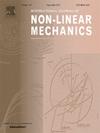不同轨道条件下列车制动稳定性及车轮磨损分析
IF 3.2
3区 工程技术
Q2 MECHANICS
International Journal of Non-Linear Mechanics
Pub Date : 2025-04-30
DOI:10.1016/j.ijnonlinmec.2025.105137
引用次数: 0
摘要
本文研究了轮轨附着条件和磨床作用对列车制动系统稳定性和车轮磨损的影响,重点研究了制动过程中的低速颤振现象。基于三体接触理论建立了三体轮轨蠕变模型,建立了包括制动块、制动盘和轮对在内的制动系统三体四自由度动力学模型。采用数值方法,研究了列车制动系统稳定性与车轮磨损的关系。研究结果表明,摩擦颤振主要发生在低速制动期间。虽然最佳的轮轨附着条件可以提高制动效率,但它们也往往会加剧制动系统内的摩擦颤振。此外,制动系统颤振引起车轮爬电波动,影响轮轨间切向力和轮轨磨损。虽然爬电振动频率在不同的轨道工况下保持一致,但在低黏着轮轨工况下,爬电振动振幅显著增大,导致车轮磨损不均匀性加剧。本文章由计算机程序翻译,如有差异,请以英文原文为准。
Analysis of braking stability and wheel wear of train under different track conditions and different grinders
This paper investigates the impact of wheel-rail adhesion conditions and grinder action on the stability of train braking systems and wheel wear, focusing on the phenomenon of low-speed flutter during braking. A three-body wheel-rail creep model is constructed based on the three-body contact theory, followed by the establishment of a three-body four-degree-of-freedom dynamic model of the braking system, which includes the brake block, brake disc, and wheelset. Using numerical methods, the study explores the relationship between the stability of the train brake system and wheel wear. The findings indicate that friction chatter primarily occurs during low-speed braking. While optimal wheel-rail adhesion conditions can enhance braking efficiency, they also tend to exacerbate friction chatter within the braking system. Moreover, brake system flutter induces fluctuations in wheel creepage, influencing the tangential force between the wheel and rail as well as wheel-rail wear. Although the vibration frequency of creepage remains consistent across different track conditions, the amplitude of fluctuation notably increases under low adhesion wheel-rail conditions, resulting in heightened non-uniformity of wheel wear.
求助全文
通过发布文献求助,成功后即可免费获取论文全文。
去求助
来源期刊
CiteScore
5.50
自引率
9.40%
发文量
192
审稿时长
67 days
期刊介绍:
The International Journal of Non-Linear Mechanics provides a specific medium for dissemination of high-quality research results in the various areas of theoretical, applied, and experimental mechanics of solids, fluids, structures, and systems where the phenomena are inherently non-linear.
The journal brings together original results in non-linear problems in elasticity, plasticity, dynamics, vibrations, wave-propagation, rheology, fluid-structure interaction systems, stability, biomechanics, micro- and nano-structures, materials, metamaterials, and in other diverse areas.
Papers may be analytical, computational or experimental in nature. Treatments of non-linear differential equations wherein solutions and properties of solutions are emphasized but physical aspects are not adequately relevant, will not be considered for possible publication. Both deterministic and stochastic approaches are fostered. Contributions pertaining to both established and emerging fields are encouraged.

 求助内容:
求助内容: 应助结果提醒方式:
应助结果提醒方式:


